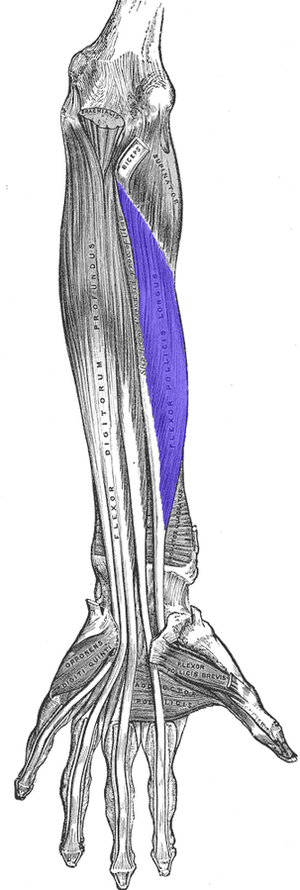Flexor Pollicis Longus
Original Editor - Uchechukwu Chukwuemeka
Top Contributors - Uchechukwu Chukwuemeka and Kim Jackson
Description[edit | edit source]
The flexor pollicis longus (FPL) is a long muscle located at the deep layer with flexor digitorum profundus and pronator quadratus in the anterior compartment of the forearm.[1] Though it is situated at the forearm, it is classified as part of the extrinsic muscles of the hand as it's function is seen in thumb movement.[2]
Origin[edit | edit source]
It originates from the mid half of the anterior surface of the radius and adjacent half of the interosseous membrane. FPL has also been found to take its origin from medial epicondyle of the humerus, coronoid process of the Ulna, and from flexor digitorium superficialis[3].
In a study by Ballesteros et al.[4] the accessory head (Gantzer's muscle)[5] of FPL has 47.1% originating from flexor digitorium superficialis, 29.4% from epicondyle of the humerus, and 23.5% is from coronoid process of the Ulna in the forearm. Hemmady et al[6] reported that of the 66.6% accessory head of FPL found, 55.5% originates from the medial epicondyle of the humerus while 16.6% is from the coronoid process of the ulna
Insertion[edit | edit source]
The muscle forms a flattened large tendon, that courses through the carpal tunnel, crossing three joints of the hand to attach at the base of the distal phalanx.
Nerve[edit | edit source]
It is innervated by the median nerve via the anterior interosseous nerve (7th and 8th cervical nerve root).
Artery[edit | edit source]
Blood supply to the Flexor pollicis longus is from a branch (anterior interosseous artery) of the ulnar artery.
Function[edit | edit source]
- The FPL mainly flexes interphalangeal joint of the distal phalanx of the thumb.
- It also serves as accessory flexors of the metacarpophalangeal of the proximal phalanx and carpometacarpal joints of the first metacarpal.
- It may also assist in wrist joint flexion.
Clinical relevance[edit | edit source]
Trigger thumb is an inability of the FPL tendon to smoothly glide through the pulley system de to pulley stenosis resulting from tenosynovitis, and most commonly involves the A1 pulley
The presence of the accessory head of FPL has several clinical implications. It can compress the median nerve and anterior interosseus nerve; the later may result in paresis or paralysis of the FDP, FPL, and pronator quadratus and the former leading to paralysis of some muscles in thenar compartment as well as sensory deficits.[8][9]
A tendinous interconnection FPL and FDP of the second digit known as the Linburg-Comstock anomaly may lead to the inability to solely flex the distal IP of the thumb and the index finger.[10]
Volkmann’s contracture, a secondary complication compartment syndrome. that causes muscle and nerve ischemia and or eventual necrosis; as the necrotic tissue recovers, scar tissue contraction results in a shortening of the affected tissue. Flexor digitorum profundus and FPL muscles are usually affected; their noticeable shortening through fibrosis explains the classic flexion deformity of Volkmann’s Ischaemic contracture.[11]
Assessment[edit | edit source]
The flexor pollicis longus is tested holding stationary the proximal phalanx of the thumb is held while flexing the distal phalanx against resistance.
[14]References[edit | edit source]
- ↑ Moore KL, Dalley AF, Agur AM. Clinically oriented anatomy. 7th ed. Baltimore, MD: Lippincott Williams & Wilkins, 2014.
- ↑ Drake RL, Vogl W, Mitchell AW, Gray H. Gray's anatomy for Students 2nd ed. Philadelphia : Churchill Livingstone/Elsevier, 2010
- ↑ Wikipedia. Flexor pollicis longus muscle. Available from:https://en.wikipedia.org/wiki/Flexor_pollicis_longus_muscle (accessed 10 October 2020)
- ↑ Ballesteros DR, Forero FL, Ballesteros LE. Accessory head of the flexor pollicis longus muscle: anatomical study and clinical significance. Folia Morphol 2019;78(2):394-400.DOI: 10.5603/FM.a2018.0091
- ↑ Benson D, Miao K. Anatomy, Shoulder and Upper Limb, Hand Flexor Pollicis Longus Muscle. In: Varacallo M. editor. 2020. Available from:https://www.statpearls.com/articlelibrary/viewarticle/36137/ (accessed 8 October 2020)
- ↑ Hemmady MV, Subramanya AV, Mehta IM. Occasional head of flexor pollicis longus muscle: a study of its morphology and clinical significance. Journal of Postgraduate Medicine. 1993; 39(1):14-6
- ↑ Nabil Ebraheim. Anatomy Of the Flexor Pollicis Longus Muscle - Everything You Need To Know - Dr. Nabil Ebraheim. Available from: http://www.youtube.com/watch?v=3CJ77o6BvKU [last accessed 10/10/2020]
- ↑ Caetano EB, Vieira LA, Sabongi Neto JJ, Caetano MBF, Sabongi RG. Anterior interosseous nerve: anatomical study and clinical implications. Rev Bras Ortop. 2018;53(5):575-581. Doi:10.1016/j.rboe.2018.07.010
- ↑ Caetano EB, Sabongi JJ, Vieira LÂ, Caetano MF, Moraes DV. Gantzer muscle. An anatomical study. Acta Ortopedica Brasileira. 2015;23(2):72-75. DOI: 10.1590/1413-78522015230200955.
- ↑ Linburg RM, Comstock BE. Anomalous tendon slips from the flexor pollicis longus to the flexor digitorum profundus. J Hand Surg Am. 1979;4(1):79-83. Doi: 10.1016/s0363-5023(79)80110-0.
- ↑ Pettitt DA, McArthur P. Clinical review: Volkmann's ischaemic contracture. Eur J Trauma Emerg Surg. 2012;38(2):129-37. Doi: 10.1007/s00068-011-0079-4.
- ↑ Nabil Ebraheim. Common Conditions Of The Thumb - Everything You Need To Know - Dr. Nabil Ebraheim. Available from: http://www.youtube.com/watch?v=YfBw3Xcdg0s [last accessed 10/10/2020]
- ↑ Dr. Abdul Hameed Senior Consultant Plastic Surgeon. Case Presentation; Flexor Pollicis Longus Tendon Injury . Available from: http://www.youtube.com/watch?v=PEasEVjW874 [last accessed 10/10/2020]
- ↑ ACM OTA Class of 2016. MMT Flexor pollicis longus & brevis. Available from: http://www.youtube.com/watch?v=M460FpCTOhU [last accessed 10/10/2020]







